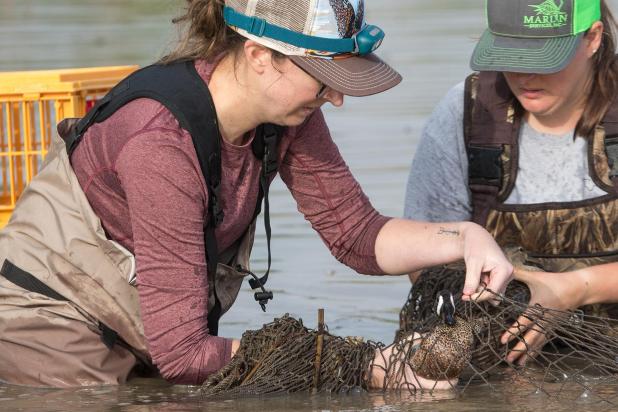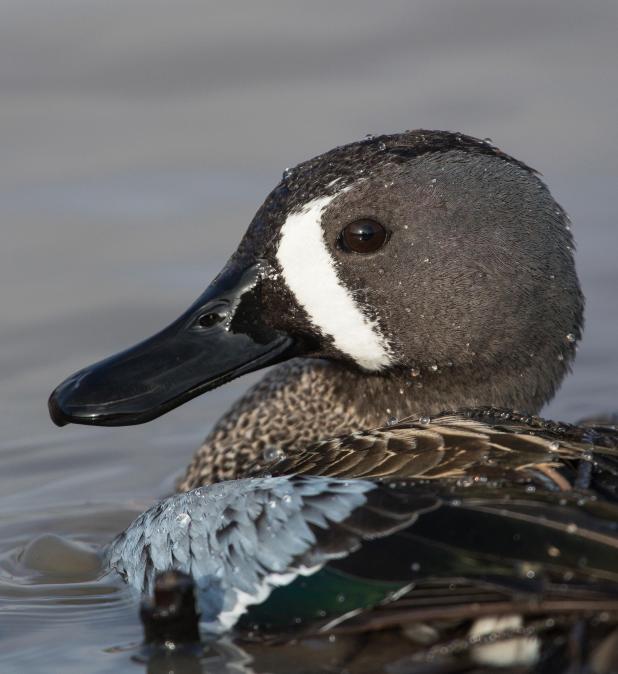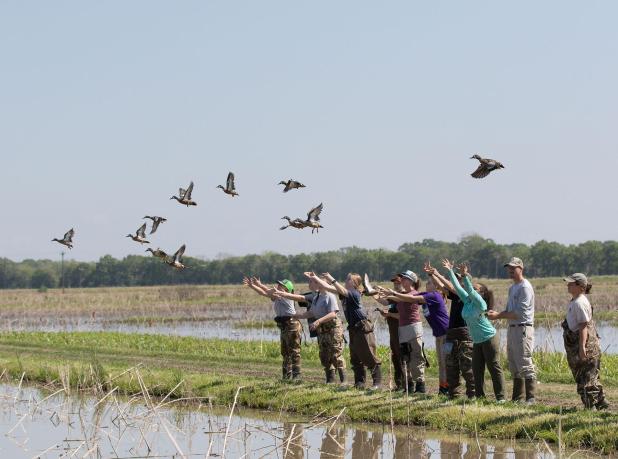
The Review/John K. Flores
Allison Vestal-Laborde works to remove a blue-winged teal from the capture net.

Researchers are studying migration patterns and the prevalence of disease among teal.

Volunteers release banded blue-winged teal.
John K. Flores: Researchers study teal for info on migration, disease
Earlier this month on a farm near Krotz Springs, Deb Carter suddenly raised her hands and in a firm voice said, “Everybody STOP!” There were nearly 400 somewhat stressed blue winged teal in crates on the ground. And raising tension a bit, some 20 eager Stephen F. Austin University student volunteers were spilling excited energy all over the levee that divided the crawfish ponds where the birds were just captured by rocket net.
The blue winged teal capture was part of a continuing program conducted each spring (March and April) by the University of Georgia Southeastern Cooperative Wildlife Disease Study and the Louisiana Department of Wildlife and Fisheries that monitors low and high pathogenic avian influenza diseases, also known as bird flu.
Carter’s moment of seriousness got everyone’s attention, quickly refocusing the group on the real reason they were there. Like a drill sergeant, she quickly gave out assignments and instructions where the SFA Ducks Unlimited collegiate chapter of volunteers became a well-oiled machine in processing the teal.
Carter, a research professional who works in the Department of Pathology in the College of Veterinary Medicine at UGA, says high pathogenic influenza has affected nearly 100 different avian species and some mammals over the past year.
Carter said, “It’s a big concern for us. Obviously, it hits the poultry farms because the wild birds are bringing it over here during their migrations. So, teal happen to be the host for some of it. They don’t always show clinical signs, but they are carriers so we’re studying them closely.
“We’ve actually been studying them for years,” Carter continued. “We’ve found low pathogenic avian subtypes in them and this past year we found the high pathogenic.”
The field capture work includes taking teal from their holding crates to a banding station, where they are banded and recorded as part of the Bird Banding Laboratory/U.S. Geological Survey scientific program. Not only does it take a large group of volunteers to clear a net of captive waterfowl, but also the systematic handling of the birds station to station before they are released; hopefully with no mortality.
After banding, the teal were taken to Carter’s station where throat and posterior swab samples were collected along with blood samples.
Swab samples let technicians know if the teal are currently carrying pathogens, where blood samples will let them know if the birds have anti-bodies.
Over the past year not only has inflation and high fuel prices caused an increase in egg prices for the consumer, but also the impact of avian influenza. One report, from Texas A&M, indicated that close to 50 million chickens in 46 states have perished due to the outbreak of avian influenza.
Allison Vestal-Laborde is a Ph.D. student in the School of Renewable Natural Resources at Louisiana State University and also works full time at the LSU School of Veterinary Medicine.
While Carter was working one end of the swabbing and bloodletting table, Laborde was working a station on the opposite end. Laborde’s interest in teal was to look for avian corona viruses.
Laborde said, “Avian corona viruses are not quite as typical as influenza right now, but as with the human side, we have a real interest in corona viruses in wildlife. We know that birds have corona virus, because it is very common in domestic poultry, but we don’t know as much about waterfowl. There have been a few studies that have shown 10% of birds are carrying avian corona viruses and we’re not quite sure what that’s doing to them.”
Laborde says part of her work is to see if waterfowl have avian corona virus when they are migrating in and out. Moreover, how does avian coronavirus effect their reproduction, because it does affect domestic poultry reproduction.
“The information would be crucially important for wildlife that are of a population like some of our cavity nesting birds,” Laborde said.
One additional station was set up, where Jeff Edwards, a University of Missouri graduate student working on his masters, was attaching GPS transmitters to nine of the healthiest blue winged teal specimens captured that morning.
The solar powered GPS transmitters track each bird’s location every four hours as long as they are in 4G cell phone coverage. Every 12 hours all of the locations are then transmitted to a data base that can be accessed and monitored, says Edwards.
Edwards said, “We’re looking to track how wetland inundation trends are effecting their habitat selection and survival throughout the non-breeding season. So, we’re kind of looking at the spring migration as to how water on the landscape is effecting how far they might make a migratory jump and if that is effecting survival during the spring season and maybe into the breeding season. So, we’re taking a look at these cross-seasonal effects by tracking them.”
The GPS transmitters are fixed to an elastic harness strapped onto the ducks body and typically weigh 10 grams. Each GPS transmitter can only equal and not exceed 3% of the bird’s weight. Most of the teal selected by Edwards weighed over 400 grams (just over 14 ounces).
Edwards said, “The first thing we do before we get going is to make sure they make weight. We want the healthiest birds we can get. So, we try to keep the birds above 400 grams.”
Female blue winged teal are usually fitted with GPS transmitters, but Edwards also included several males. According to Edwards, it’s not common for people to study males.
“People seem to think blue wing males exhibit different migration strategies and to my knowledge nobody in the world has put transmitters on male blue winged teal, which is crazy. So, it will be cool for us to look at that and differentiate survival where fall migration and resource selection is concerned,” Edwards said.
Whether a biologist, grad student, or volunteer, there’s nothing quite like messing around with waterfowl. One of the things the SFA student volunteers got to see were all three North American teal species. Both the blue winged teal and green winged teal are common to the Mississippi Flyway that Louisiana is part of. But, as a treat the group also got to see a cinnamon teal that is considered more of a Central and Western Flyway duck.
The Nacogdoches, Texas, Stephen F. Austin collegiate chapter has about 40 total members according to Club President, Brittany Zwahr, with 20 being relatively active.
The group spends considerable time maintaining wood duck boxes on local WMAs in Texas, as well as volunteering to help out with various wetland conservation projects.
Globally, the concern of various diseases spreading remains at the forefront of people’s mind.
Monitoring diseases carried by wildlife, particularly waterfowl, acts as an early warning signal, where agriculture agencies can develop strategies to mitigate outcomes.
John Flores is the Morgan City Review’s outdoor writer. He can be contacted at gowiththeflo@cox.net.
